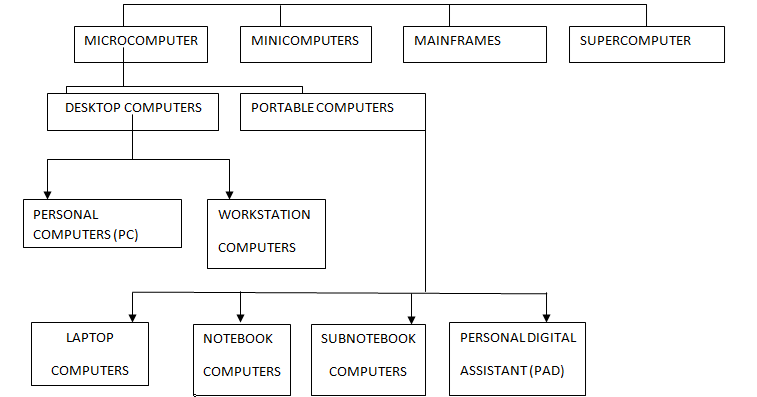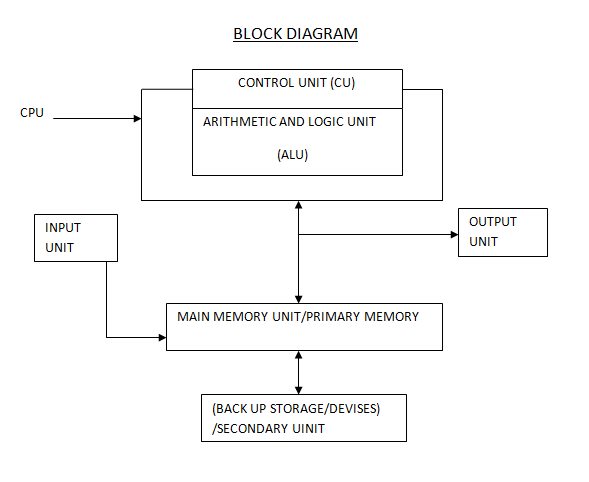THE HARD DISK DRIVE – SUB- DIVISIONS OF THE HARD DISK
The hard disk is further sub-divided into two types:
(a) Fixed disk or inflexible disk: It is not portable
(b) Removable disk.
FIXED DISK (FIXED HARD DISK)
– It is a type of magnetic media that stores items using magnetic patterns.
– It also a read/write storage media; (that is you can both read from and write on a hard disk any number of times)
– This is non removable magnetic disk assemblages used in magnetic disk units.
– On microcomputer, fixed disks are permanently mounted/housed inside the computer chassis (system unit)
– The capacity of a fixed disk in modern desktop personal computers ranges from 20 MB to 1 GB.
– On microcomputers and mainframes, fixed disks can be permanent or removable
– It is not portable.
– It allows higher speeds greater data recording densities, and closer tolerances within a sealed, more stable environment.
– Fixed disks can be stacked together. The result is called a disk pack.
A disk pack is easy to handle.
FLEXIBLE DISK, (FLOPPY DISK), FLOPPY OR DISKETTE
OR MAGNETIC DISKETTE
– It is a disk that consists of polyester film coated with an iron oxide compound.
– It is a thin, circular, flexible, plastic disk with a magnetic coating enclosed in square-shaped plastic shell.
Characteristics of diskettes
(i) It is portable
(ii) It is not expensive
(iii) It is square shape
(iv) It is reusable
(v) It is easy to store
A floppy disk drive –is a device that can read from and write to a floppy disk.
Standard types of diskettes
There are two standard types of diskettes
- The 5 ¼ inches diskettes
edu.uptymez.com
- This is an old type of diskettes and it is being phased out.
- It is in a soft (flexible) housing (jacket)
- Its capacity ranges from 356 KB to over 1 MG of data.
edu.uptymez.com
- The 3 ½ inches diskettes type.
edu.uptymez.com
- It is a new type and is still in use
- It is mounted in a hard plastic cover (housing)
- It is has a larger/ higher storage capacity
- It weighs less
- It consumes less power
- It is smaller, studier and easier to store. It lifts into a T- shirt pocket or purse.
edu.uptymez.com


USES OF DISKETTES
Diskettes are used:
- To move data and programs from one computer to another
- To back up critical data on the fixed disk.
edu.uptymez.com
THE MAIN FORCES THAT ARE HOSTILE TO THE DISKETTE (FLOPPY DISK OR FLOPPIES)
Floppies are endangered by several factors (things, or forces)
The main forces (things) that are hostile (dangerous) to floppies are
(i) Dust
(ii) Magnetic fields
(iii) Liquids
(iv) Temperature extremes
(v) Vapours
HOW TO HANDLE DISKETTES:
RULES FOR TAKING CARE OF FLOPPIES
1. Do not touch the disk surface.it is easily contaminated, which causes errors.
- Do not use alcohol thinners or freon to clean the disk
- Do not use magnetic or magnetized objects near the disk. Data can lost from a disk exposed to a magnetic field
- Do not bend or fold the disk
- Do not place heavy objects on the disk
edu.uptymez.com
6. Do not use rubber band or paper clips on the disk
7. Do not use erasers on the disk
8. Do not expose the disk to excessive heat or sunlight
9. Apply the index label to the right of the manufacture
10. Write on the index label with left-tip pen only
11. Insert carefully by grasping upper edge
THE ARITHMETIC – LOGIC UNIT (ALU)
- Is a component of the CPU (central processing unit) that performs arithmetic operations and logical operations and controls the speed of those operations.
- Is the calculating device for the computer.
edu.uptymez.com
PARTS OF THE ALU
The ALU is made up of two sections or parts:
- THE ARITHMETIC SECTION (OR ARITHMETIC PART)
edu.uptymez.com
This is a part of the ALU, which deals with the arithmetic operations.
Some examples of arithmetic operations performed by the arithmetic section (or arithmetic part) of the ALU are: addition, substraction, multiplication and division.
- THE LOGIC SECTION (OR THE LOGIC PART)
edu.uptymez.com
This is a part of the ALU, which handles or deals with the logical operations (or decision making operations)
Some examples of logical operations performed by the logical section (or logical part) of the ALU are: comparing, selecting, matching, sorting and merging.
FUNCTIONS OF THE ALU
The Arithmentic – logical Unit has two main functions:
- To do (carry out) arithmetic operations e.g. addition, subtraction, multiplication and division.
edu.uptymez.com
2. To do (perform) logic operations e.g. comparing, selecting, matching, sorting and merging.
The ALU does not store data. It merely performs the necessary manipulations. For example; if a program tells the computer to add or subtract two or more numbers; the control unit has those numbers copied into special memory areas called registers or accumulators. The ALU then manipulates these memory areas and returns the result to the appropriate memory location as directed by the control unit.
CHARACTERISTICS OF THE ALU
- It receives commands from the control unit (CU)
- It contains additional storage locations called REGISTERS
edu.uptymez.com
The ALU does not store data. It merely perfoms the necessary manipulation
TYPES (CLASSIFICATION) OF COMPUTERS
- MICROCOMPUTERS:
edu.uptymez.com
Are the most widely used and the fastest growing type computers
They run easy – to – use application. There are two categories of microcomputers
- Desk-tops: – They fit on desk top, and are used by a wide range of people. Personal computers (PC) and Workstations are types of desktop computers.
- Portables: – Small and light, easy to move from one place to another.
edu.uptymez.com
Examples are: Laptops, Notebooks, and Sub notebooks
- MINICOMPUTERS: –
edu.uptymez.com
They fall between Mainframe and Microcomputer in their processing speed and data-storing capabilities. They are used for special purposes e.g. in researches or monitoring a particular manufacturing process.
- SUPERCOMPUTERS:
edu.uptymez.com
Are the most powered high capacity computers used by very large organizations, e.g. NASA for tracking space explorations.
- MAINFRAMES:
edu.uptymez.com
Are large computers occupying specially wired, air conditioned rooms. They have great processing speed and data storage. Are used by banks, government agencies insurance companies, Airline reservation systems etc.
TYPES OR CLASSIFICATION OF COMPUTERS
COMPUTERS

THE PROCESSOR OR CENTRAL PROCESSING UNIT (CPU)
Objectives
This unit is intended to enable students to understand:
- The meaning of CPU
- Parts of CPU
- Functions of the CPU
- Block diagram to Data and Command flow
- Meaning of main memory
- Major divisions of the main memory
- The RAM
- Functions of RAM
- The ROM
- Function of ROM
- Differences between RAM and ROM
edu.uptymez.com
THE PROCESSOR or CENTRAL PROCESSING UNIT (CPU)
THE CENTRAL PROCESSING UNIT (CPU)
A CPU is the central processing unit,Basically its the brain of computer.Also called a processor.
– Is the part of the computer system that runs the program instructions.
– Is the part of the computer system that follows the instructions to manipulate (or change) data into information.
COMPONENTS (PARTS) OF THE CPU (PROCESSOR)
The CPU is made up (or consists) of two main parts.These are: –
- The Arithmetic – Logic unit (ALU)
- The Control Unit (CU)
The Arithmetic Logic Unit
edu.uptymez.com
Main functions
(i)Performs mathematical Operations(+,-,×,÷)
(ii)Performs Logic operations(=,>,< ,(≠),=<,>=)
Control Unit
Main functions
(i)Control all functions of computer
(ii)Control ALU

There are FEW AUTHORS who say that the CPU is made up (or consists) of THREE main parts. These are: –
- The control unit (CU)
- The Arithmetic- Logic Unit (AlU)
- The main memory unit (MMU)
edu.uptymez.com
It should be noted here that this view is a misconception.
FUNCTIONS OF THE CPU OR PROCESSOR
The basic functions of the CPU are following: –
(i) To control the sequence of operations according to instructions
(ii) To give commands to all other parts of the computer system
(iii) To carry out processing (i.e. to process data into information)
(iv) To send processed results to the output
(v) To store data and all the instructions.
OUTPUT DEVICES
These are devices that give result from a computer.
E.g: Printers, Plotters, Speaker, Fax- machine, Monitors, Projectors, Smart card.
TYPES OF OUT PUT DEVICES
i) SOFT COPY OUT PUT DEVICES
ii) HARD COPY OUTPUT DEVICES
SOFT COPY OUT PUT DEVICES
1) MONITORS
Output devices used to display images and text.
ADVANTAGES
– Relatively cheap
– Reliable
– They are quite
– Do not want paper
2) SPEAKERS
Output device which produce sound from the computer.
3) Light – Emitting diode (LED)
These are small power device which emit light.
Uses
Are used to indicate various events
E.g.:
– Power is on
– Hard disk is in operation
– Monitor is working
HARD COPY OUTPUT DEVICES
Produces hard copy out-put.
E.g:
– Printers
– Fax machines
– plotters
– Some photocopy machine can print
PRINTERS
Produce images or text on a paper.
TYPES OF PRINTERS
1) Impact printer
2) Non- impact printer
- IMPACT PRINTER
edu.uptymez.com
Produce characters object by using hammers or pun shield on a print head
E.g; Dot- matrix printer
HOW IT WORKS
Printer head has a set of pins which hit an ink ribbon to form characters on paper.
Uses:-Used to print multiple copies black and white text.
ADVANTAGES
– Low running cost
– Purchase cost is low
DISADVANTAGES
– Wet the paper
– Make noise
– Low quality
-Difficult to edit
- NON – IMPACT PRINTER
edu.uptymez.com
These are printers which produce characters without striking the paper. No direct contact between paper and print head.
E.g:
- Ink jet printer
- Laser printer
- Thermal transfer printer
edu.uptymez.com
INK JET PRINTER
This is the non- impact printer which uses tiny nuzzles to form the character or graphic image.
Uses
– Used commonly at home and schools
– Can be used in offices
ADVANTAGES
– Produce high quality copies
– Produce colored copies
– Relative less expensive
– Easy to edit.